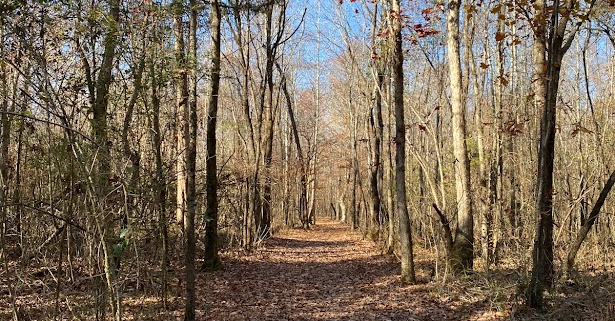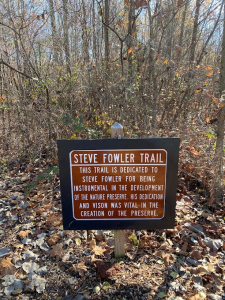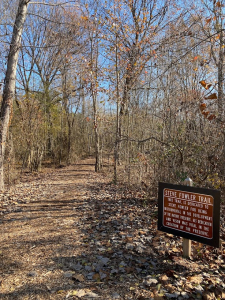Dallas Fanning Nature Preserve
Friend and fellow Nature-enthusiast Jim Chamberlain and I visited Huntsville, Alabama’s Dallas Fanning Nature Preserve November 28, 2022. This was the first time either of us had explored the 58-acre preserve. I had no preconceived notions of what to expect. I offer photographs, observations, and initial reactions.
Trailhead
An ample gravel parking lot (the green area in the northwest corner of the map below) awaits visitors. Several picnic tables dot the grass below right.
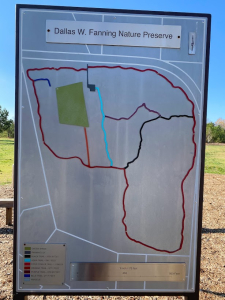
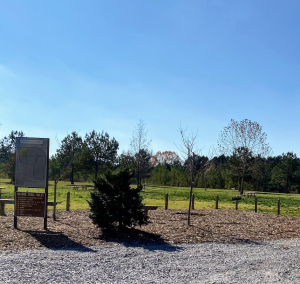
A developer donated the property to the City 15 years ago. Rather than drafting an overview of the fairly new preserve, I give you this excerpt dated July 20, 2022 from the Huntsville.gov website:
The City of Huntsville opened its newest nature preserve on 58 acres of land off Martin Road West. Named in honor of the late Dallas W. Fanning, former director of urban development and architect of the City’s western expansion, the park will provide residents in the westernmost part of the City with outdoor trails for exercise, passive recreation, stargazing and nature hikes.
“I can’t think of a more fitting tribute to Dallas Fanning than this preserve,” said Mayor Tommy Battle. “Dallas was the catalyst for Huntsville’s western expansion. His vision brought industry and thousands of jobs and new residents to the western corridor. He would have wanted these residents to have places to play and this park would please him greatly.”
The nature preserve provides several miles of signed trails through the woods and a two-acre green space dotted with shade trees and benches. There is a gravel parking lot at the park entrance, but no lighting – an intentional decision.
“This parcel includes woodlands and wetlands,” said John Hamilton, City Administrator. “In developing the park, we worked to enhance and preserve the environment and provide residents with a sanctuary space to connect with nature. By eliminating lighting, we protect wildlife habitats and provide an excellent location for stargazing.”
The trail we hiked (Steve Fowler Trail) bears the name of a key participant in designing and constructing the trail and associated benches and signage:
“One of our supervisors, Steve Fowler, helped design the trails and provided all the carpentry for the benches and signage. He and his enthusiastic crew of workers have taken great pride in bringing this amenity to the public.”
The 58 acres encompass several unique ecosystems. Walking the property perimeter trail clockwise, we passed through ecotypes I’ve designated as: young upland forest; regenerating upland forest; stripped wasteland; riparian forest; open fields.
Young Upland Forest
I’m estimating that the “young” adjective describes a 25-35 year old naturally regenerated upland hardwood forest with occasional loblolly pine. The stand does not express a closed full canopy, suggesting some disturbance punctuating forest development. The flat, woodchip-covered trail provides easy walking and firm-cushioned strolling. The trek is suitable for hikers of all ages and abilities. The scenery, while not approaching spectacular, is pleasant, especially through the eyes of a seasoned Nature-enthusiast who ponders the history written in the land and its forest cover.
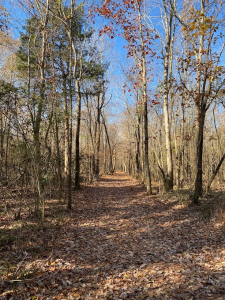
We discovered multiple stump clusters like the sycamore where Jim is standing below left, with its seven stems around a rotted mother-tree stump. The sprouts, clones of the severed parent, began from adventitious buds sprouting at the stump’s rim the year after harvesting. The double sprout-origin green ash tree below right grew from its own severed parent stump. I assume that all of the stump clusters originated from the same tract-wide harvesting operation.
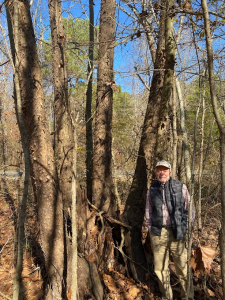
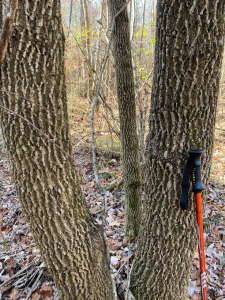
The white oak cluster below left tells the same tale, as does the yellow poplar grouping at right. Most of our northern Alabama hardwoods regenerate readily via sprouting from adventitious buds.
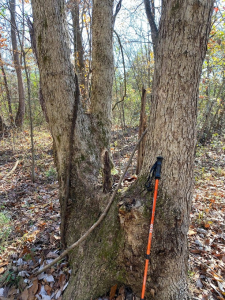
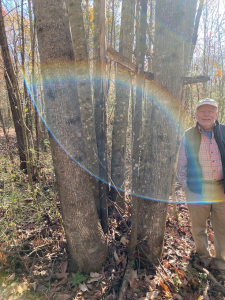
For example, the January 1, 2022 tornado-ravaged forest at the Wheeler National Wildlife Refuge had already sprouted aggressively by May 27, 2022. Nature does in fact abhor a vacuum…and she acts quickly to fill any void.
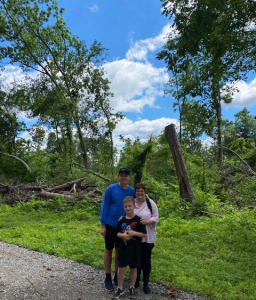
Vegetative regeneration works effectively for our regional hardwood species. Wholesale blowdowns regenerate in-place without the chance and delay associated with relying upon seedfall and germination. In contrast, regeneration by seed is a necessity for a forest to colonize an abandoned field or a fire-ravaged forest. Vegetative reproduction ensures that the exact genotype carries forward. Sexual reproduction advances the combined genotype of both parents. Nature carries a full bag of alternative strategies for ensuring that life persists.
Here is a Dallas-Fanning beech that sprouted stems close enough on the cut stump that they have grown together into what appears to be transforming into a single multi-columned stem. Most tree form oddities and curiosities tell a story that the astute Nature enthusiast can interpret.
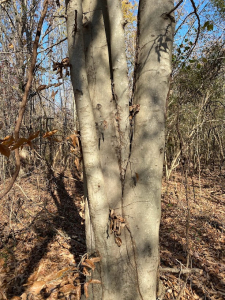
This elm suffered an injury during the harvest that stimulated the common stump clusters. I picture a top or felled tree impacting the then sapling elm at about three feet from the ground. The top broke severely enough to terminate life at six feet from the base, leaving a permanent pump-handle effect there. At the three-foot mark the elm sent a shoot vertical…one that now serves as the two-pronged fork reaching into the forest canopy.
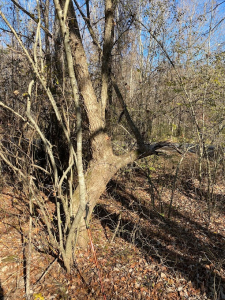
There are many who see native American marker trees in every such tree form oddity…insisting that the the elm above is directing the observer to a nearby spring, trail intersection, or some other landscape attribute important to fellow Native Americans. I am a marker tree bubble-burster. Natives haven’t frequented our wildlands for the past 170 years, at least 130 years before this elm germinated from seed!
I recorded a brief video within the upland forest that includes another such marker tree form, in this case a white oak:
A red oak stump cluster reveals a window into a hollow tree base. The open wound resulting from the chainsaw-severed trunk provides a wide-open infection court for decay fungi. Because these three major sprouts occurred on the 18-24-inch high stump rim, the vertical stems constituting the multi-stemmed new tree will likely have heart rot extending into their trunks.
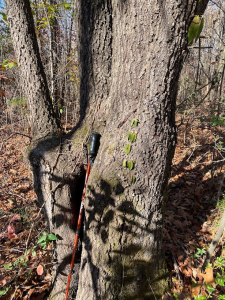
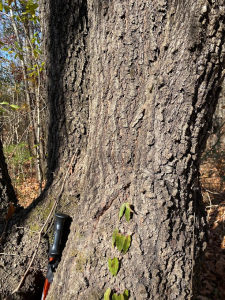
This red oak oddity is even more curious. Imagine a cut stump at the height of my trekking pole. Multiple sprouts emerged from the stump ridge, which at the time was a much smaller diameter than now. Five sprouts survived to today, four of the five large enough to reach into the mani canopy. The stump wound has successfully calloused over the entire cut surface. The irregular swelling (a bloated appearance) suggests that heart rot infects the stump.
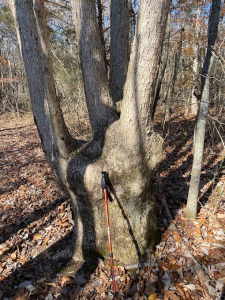
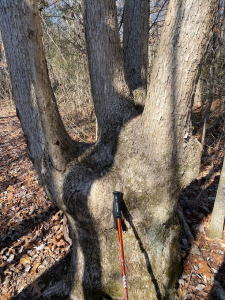
Here is another view of the tree (left) and a look into the crown where the four larger stems access full sunlight.
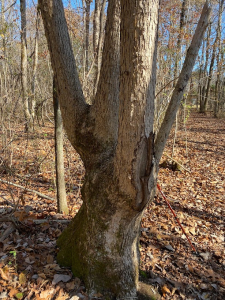
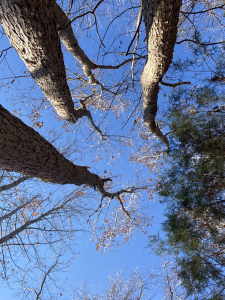
This final view captures the irregular swelling at the old stump level.
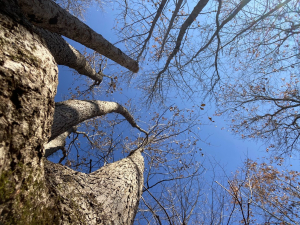
Every tree, every stand, and every forest tells a story, this curious individual oak being no different.
The three-stemmed beech (below) adds two additional elements to its tale. A grape vine (to the left of the three stems) accompanied the rising stump sprouts as they reached skyward. Beech saplings tend to hold their spent leaves through the winter, a pattern termed marsences, adding nice winter color to an otherwise drab season.
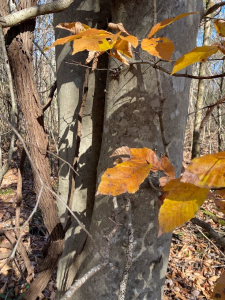
Not all grape vines are fortunate enough to find a route into the main canopy. This tangle of vines have smothered a small hickory, condemned to a terminal height only within the mid-canopy levels.
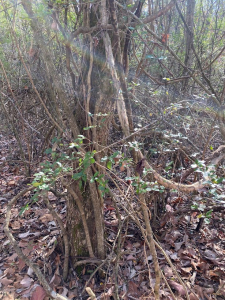
Another hickory nearby served a poison ivy vine more favorably. The vine and a patch of moss caught my eye. Nature rewards those of us willing to look closely to discover the beauty, magic, wonder, and awe!
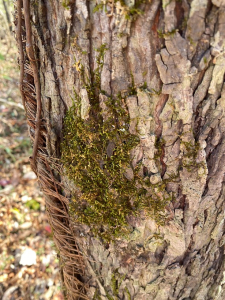
Regenerating Upland Forest
We entered a distinctly different, younger forest type, this one composed of mixed brush, young hardwood and scattered loblolly pine…naturally regenerated on what appears to be abandoned meadow. I saw no evidence of stumps that would indicate a former forest.
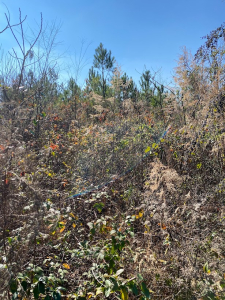
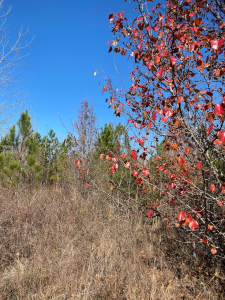
Intermixed bradford or callery pear likewise indicates early succession, the ornamental pear (below right and left) being adept at colonizing open land. The seed (below right) attracts birds that consume the fleshy fruit and distribute the indigestible seeds.
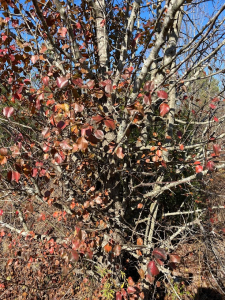
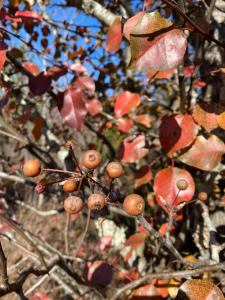
As with other types across the Preserve, I recommend that managers place permanent photo points so that visitors to what will mature into a high forest fifty years hence can view photographs of its early stages in 2022. This path will, with time, pass through a deeply shaded mixed pine hardwood forest.

I recorded this brief video to give readers a better sense of the land and its vegetation.
We walked from the regenerating meadow into several acres that had been stripped to clayey and graveley subsoil, I suppose prompting the developer to donate this wasteland to the City 15 years ago. I assume that the stripped soil material provided fill to the nearby offsite light industrial and commercial development.
Stripped Wasteland
I don’t want to give the impression that the donation should not be appreciated. Time will heal some of the injury. Except for the stripped wasteland, another three to five decades will yield a high forest across the Preserve. However, it may take centuries for this sparsely vegetated wasteland site to develop soil and regain a trace of fertility. The exposed dirt (I refuse to honor it with the term soil) is more like pavement than growing medium. The pines that have germinated are chlorotic, slow growing specimens…and will struggle to survive during dry years.
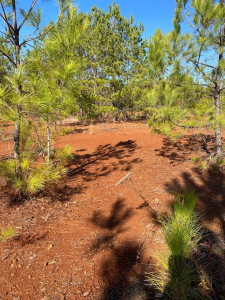
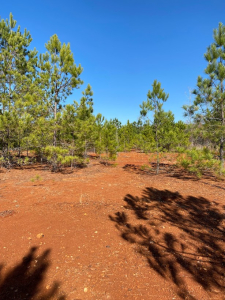
The sweetgum (left) is hanging on to life, but is showing sign of severe stress, resembling a bonsai creation. The image of dirt (not soil! below right) could have been photographed by the Mars Rover!
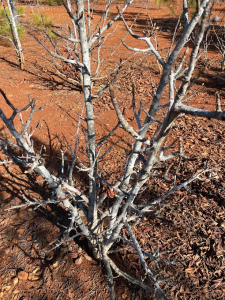
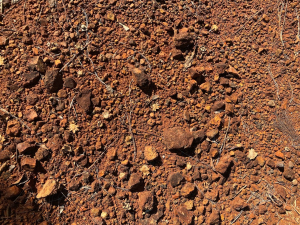
We witnessed several of the taller volunteer pines that have recently yielded to wind, their constrained roots insufficient to support them on this harsh site.
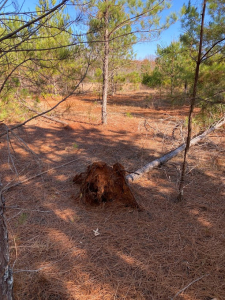
What a story this hike will reveal as the decades pass. I urge the City to establish 10-20 permanent photo-points in the near term, to chronicle conditions now and every 5-10 years, providing a long-term record of change in support of ongoing education and interpretation. A picture is, in fact, worth a thousand (ten thousand!) words.
Riparian Area
We entered a riparian forest before returning to the trailhead. The only direct evidence of its seasonal flooding came in the form of two culverts crossing under the elevated trail, each one, like this one, 18-24 inches above the forest floor. I must return during the wetter winter months to see first hand the flooding.
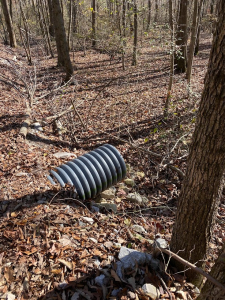
Open Fields
We completed our circuit, re-entering the open fields. I repeat an earlier observation. While only 58 acres, all within a scarred industrial and commercial development area, the Dallas Fanning Nature Preserve tells a compelling story that will only become more compelling over time.
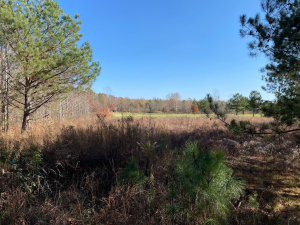
The Preserve offers a window into a disturbed landscape, one not unusual in an area converting from mixed agriculture to industrial and commercial development. Wildness may be a remnant of what is left behind by the development that sweeps across the face of the land. The 58-acres show the wounds of past practice that happened to it…not from a systematic plan to protect existing highly prized wildness. Nevertheless, this abused land tells an important story. Long term it can be a Phoenix rising. Current and future visitors will appreciate its gentle hiking trails, even as they learn from the visible intersection of human and natural history. Even now, it stands as a slice of wildness in a region of the city rapidly changing.
Thoughts and Reflections
I offer these observations:
- We can find rewarding wildness even in the wake of rapid commercial and industrial development.
- I value Nature’s beauty, magic, wonder, and awe whether in deep wilderness or at the fringe of Alabama’s fastest growing city.
- Nature reveals her secrets to those most willing to explore her past and anticipate her future — every forest tells the story of past, present, and future influences.
Inhale and absorb Nature’s elixir. May Nature Inspire, Inform, and Reward you!
Note: All blog post images created & photographed by Stephen B. Jones unless otherwise noted. Please circulate images with photo credit: “©2023 Steve Jones, Great Blue Heron LLC. All Rights Reserved.”
Another Note: If you came to this post via a Facebook posting or by an another route, please sign up now (no cost… no obligation) to receive my Blog Post email alerts: http://eepurl.com/cKLJdL
And a Third: I am available for Nature-Inspired Speaking, Writing, and Consulting — contact me at steve.jones.0524@gmail.com
Reminder of my Personal and Professional Purpose, Passion, and Cause
If only more of us viewed our precious environment through the filters I employ. If only my mission and vision could be multiplied untold orders of magnitude:
Mission: Employ writing and speaking to educate, inspire, and enable readers and listeners to understand, appreciate, and enjoy Nature… and accept and practice Earth Stewardship.
Vision:
- People of all ages will pay greater attention to and engage more regularly with Nature… and will accept and practice informed and responsible Earth Stewardship.
- They will see their relationship to our natural world with new eyes… and will understand more clearly their Earth home.
Tagline/Motto: Steve (Great Blue Heron) encourages and seeks a better tomorrow through Nature-Inspired Living!
Steve’s Three Books
I wrote my books Nature Based Leadership (2016), Nature-Inspired Learning and Leading (2017), and Weaned Seals and Snowy Summits: Stories of Passion for Place and Everyday Nature (2019; co-authored with Dr. Jennifer Wilhoit) to encourage all citizens to recognize and appreciate that every lesson for living, learning, serving, and leading is either written indelibly in or is powerfully inspired by Nature.
I began writing books and Posts for several reasons:
- I love hiking and exploring in Nature
- I see images I want to (and do) capture with my trusty iPhone camera
- I enjoy explaining those images — an educator at heart
- I don’t play golf!
- I actually do love writing — it’s the hobby I never needed when my career consumed me
- Judy suggested my writing is in large measure my legacy to our two kids, our five grand kids, and all the unborn generations beyond
- And finally, perhaps my books and Blogs could reach beyond family and touch a few other lives… sow some seeds for the future

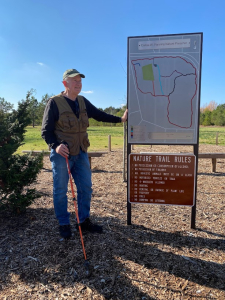
All three of my books (Nature Based Leadership; Nature-Inspired Learning and Leading; Weaned Seals and Snowy Summits) present compilations of personal experiences expressing my (and co-author Dr. Wilhoit for Weaned Seals and Snowy Summits) deep passion for Nature. All three books offer observations and reflections on my relationship to the natural world… and the broader implications for society. Order any and all from your local indie bookstore, or find them on IndieBound or other online sources such as Amazon and LifeRich.

